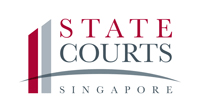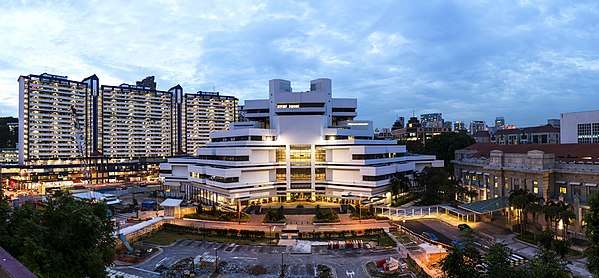State Courts of Singapore
The State Courts of Singapore (formerly the Subordinate Courts[1]) is one of the two tiers of the court system in Singapore, the other tier being the Supreme Court. The State Courts comprise the District and Magistrate Courts—both of which oversee civil and criminal matters—as well as specialised courts such as the coroner's courts and the Small Claims Tribunals.
| State Courts, Singapore | |
|---|---|
 | |
| Jurisdiction | Singapore |
| Location | State Courts Building, No 1 Havelock Square, Singapore 059724 |
| Composition method | District judges and magistrates are appointed by the President upon the recommendation of the Chief Justice |
| Appeals to | Supreme Court of Singapore |
| Website | https://www.statecourts.gov.sg/; Facebook |
| Presiding Judge | |
| Currently | Vincent Hoong Seng Lei |
| Since | 1 April 2020 |
| Deputy Presiding Judge | |
| Currently | Jennifer Marie |
The State Courts comprise district and magistrate courts and hear both civil and criminal cases that do not fall under the jurisdiction of the Supreme Court. Over 90% of all judicial cases in Singapore are heard in the State Courts. Its annual volume averages about 350,000 cases.[2]
The district judges, magistrates, and registrars of the State Courts are all legal service officers and serve under the supervision and control of Singapore's Legal Service Commission. District judges and magistrates are appointed by the President upon the recommendation of the Chief Justice.
Main Operational Units
According to the latest Annual Report published by the State Courts,[3] there are six main operational units in the State Courts. They are the Civil Justice Division; the Community Justice & Tribunals Division; the Criminal Justice Division; the Centre for Dispute Resolution; the Corporate Services Division; and the Strategic Planning & Technology Division.
The Presiding Judge of the State Courts, a position held by a Supreme Court Judge or Judicial Commissioner, has overall responsibility for the administration of the State Courts. The Presiding Judge leads a team of judicial officers who adjudicate on cases brought before the State Courts. He is assisted administratively by the Deputy Presiding Judge and Registrar.
In October 2014, the Family Justice Courts were formed, and therefore family and youth-related cases no longer fall under the purview of the State Courts.
Senior Judicial Officer
The senior judicial officers of the State Courts are:
- Vincent Hoong Seng Lei, Presiding Judge of the State Courts; 2020 -
- Deputy Presiding Judge of the State Courts Jennifer Marie;
- Registrar Christopher Tan;
- Principal District Judge (Civil Justice Division) James Leong;
- Principal District Judge (Community Justice and Tribunals Division) Siva Shanmugam;
- Principal District Judge (Criminal Justice Division) Toh Han Li;
- Principal District Judge (Criminal Justice Division) Victor Yeo;
- Principal District Judge (State Courts Centre for Dispute Resolution) Thian Yee Sze; and
- Principal Director (Strategic Planning and Technology Division) Toh Yung Cheong.
Prior senior judicial officers
- Justice See Kee Oon, Presiding Judge of the State Courts; - 2020
The State Courts Building
The State Courts (then known as the Subordinate Courts) officially began operating at 1 Havelock Square on 15 September 1975. The construction of the State Courts Building marked the centralisation of the delivery of justice from various courthouses to one courthouse at 1 Havelock Square. Prior to 1975, the Criminal District and Magistrates’ Courts were located in South Bridge Road, between North Canal Road and Upper Pickering Street; the Traffic Courts were housed in the former Sepoy Lines Police Station in Outram; while the Civil District Courts operated out of the old Parliament Building and the Supreme Court Building at St. Andrew’s Road.
In designing the Building, much thought was put into the movement and circulation of the judicial officers, the court administrators, persons in custody and court users, with these groups having segregated routes in certain areas. The movement and circulation requirements became the foundation of the Building’s iconic design that involved the geometric distribution of the courtrooms in an octagonal formation with a central atrium. Its facilities also incorporated many innovative features that were ahead of its time. The Building was one of the first “fireproof” government buildings in Singapore with its sprinkler system that was put in place as part of the anti-fire measures to protect the wooden wall panels in the courtrooms. It also features an environmentally-sensitive design, through the use of natural lighting to illuminate the atrium.
When first completed in 1975, the Building housed 26 courtrooms. To cope with an increasing caseload, more courtrooms were added over the years. Today, there are 40 courtrooms and 28 hearing chambers. The services provided by the State Courts have also increased over the past four decades to better serve the community. The building achieved conservation status on 10 July 2013.[4]
The State Courts building is described to be an example of Modern Brutalist architecture[5], with its angular shapes and fortress-like appearance. This style of architecture was popular with government buildings in the 1970s and 80s.[6]
In 2020, the State Courts moved to a new building, which still retaining its address of 1 Havelock Square. The new building, known as State Courts Towers[7], is located next to its former premises and occupies a space that used to be an open-air carpark.[7]
The Community Justice Centre
In light of the growing number of litigants (LiPs) who choose to represent themselves in court, a one-stop hub that provides greater integration of legal aid and social assistance to LiPs was deemed necessary. On 20 June 2012, the Ministry of Community Development, Youth and Sports (now renamed as Ministry of Social and Family Development), Ministry of Law, Subordinate Courts (now renamed as State Courts), Tan Chin Tuan Foundation, and the Law Society of Singapore entered into a Memorandum of Understanding to establish a Community Justice Centre (CJC) that seeks to assist unrepresented litigants through its services.[8]
The Community Justice Centre (CJC) is an independent charity with IPC (Institute of Public Character) status conferred. Based in the State Courts, the CJC is committed to ensuring litigants in person (LIPs) have access to justice through community partnership. CJC aims to provide a wide range of support services for the litigants in Person (LIPs) and their family members. It will provide free practical and emotional support to LIPs in need as well as free legal advice at the legal clinics. Through the support of the CJC, the LiPs should be able to better present their case, follow proceedings and understand judicial rulings or pronouncements in their respective cases. In collaboration with other social services agencies, the CJC also hopes that the underlying social problems and concerns for the LiPs and their family members can be addressed.[9]
The Patron of the CJC is Chief Justice Sundaresh Menon.
The New State Courts Towers

Design
As stated in a media release published by the State Courts,[10] the State Courts Towers will comprise two towers, each about 178-metre high, with an area of 113,000 sqm. They will be linked by a series of sky bridges that enable the controlled circulation of court visitors and staff of the State Courts. The Court Tower will comprise the courtrooms, hearing chambers and court supporting functions, and the Office Tower will house the offices and other support functions.
The two towers are designed to be eco-friendly and will feature naturally-ventilated corridors and high-rise gardens to provide shade from the afternoon sun. The high-rise sky terraces will bring green relief to the built-up city and provide soothing gardens to the users. The towers will also use renewable energy such as solar power panels.
When completed, the State Courts Towers will accommodate over 60 courtrooms and over 50 hearing chambers. Court users can also look forward to improved service counters, designed to better address their needs.
The design of the new State Courts Towers derived from an open design competition held in September 2011. The project comprises a development of a new tower and retrofitting the existing State Courts Building. Serie Architects and Multiply Architects & Engineers LLP has been awarded the assignment in June 2012, and will work with CPG Corporation to implement the submitted design.[11] It was shortlisted from the 19 proposals submitted.
Groundbreaking and Construction
The State Courts Towers' groundbreaking ceremony took place in May 2014.[12] Piling works and service diversions began in June that same year.
The contract for the construction of the State Courts Towers has been awarded to Samsung C&T Corporation in early 2016. The contract comprises the construction of the two connected towers. Construction works are expected to start by the second quarter of 2016. The estimated construction period is about 36 months, and the State Courts Towers are slated to be operational from 2020.
Awards and Achievements
2012 United Nations Public Service Award
The establishment of the Help centre - which stands for Helping to Empower Litigants- in-Person - clinched the State Courts the second prize in the category of 'Improving the Delivery of Public Services' for Asia and the Pacific region.[13]
2011 Singapore Quality Award with Special Commendation
The State Courts of Singapore won the coveted Singapore Quality Award 2011 with Special Commendation (SQA-SC), an award which represents the pinnacle of business excellence in Singapore.
2011 – Attained Singapore Quality Award with Special Commendation (SQA-SC)
2006 – Attained Singapore Quality Award (SQA)
2001 – Attained Singapore Quality Class (SQC)
Gallery
 Family Court
Family Court Entrance to the Subordinate Courts
Entrance to the Subordinate Courts
References
- "INDRANEE RAJAH, LAW Subordinate Courts renamed State Courts, to be led by High Court judge". Straitstimes.com. 2014-01-21. Retrieved 2014-09-09.
- https://www.mlaw.gov.sg/content/minlaw/en/news/parliamentary-speeches-and-responses/second-reading-speech-on-subordinate-courts-amendment-bill.html
- "Annual Report 2015 - Delivering Justice to the Community".
- "MEDIA RELEASE: STATE COURTS BUILDING AT 1 HAVELOCK SQUARE TURNS 40 ON 15 SEPTEMBER 2015".
- "ARCHIGARDENER -". ARCHIGARDENER.
- "Page Not Found". www.ura.gov.sg.
- hermesauto (2019-11-29). "State Courts to start moving to new State Courts Towers building from Dec 9". The Straits Times. Retrieved 2020-03-27.
- "CJC - Our History". Archived from the original on 2016-03-19.
- "About CJC". Archived from the original on 2016-04-22.
- "MEDIA RELEASE: STATE COURTS AWARD CONSTRUCTION CONTRACT".
- "Winning design for new Subordinate Courts Complex selected". Channel News Asia. 2014-06-05. Archived from the original on 2014-09-08. Retrieved 2014-09-09.
- "MEDIA RELEASE: GROUNDBREAKING CEREMONY FOR NEW STATE COURTS COMPLEX ON 28 MAY 2014".
- "Subordinate Courts win United Nations Public Service Award". Straitstimes.com. 2012-06-05. Retrieved 2012-07-12.

